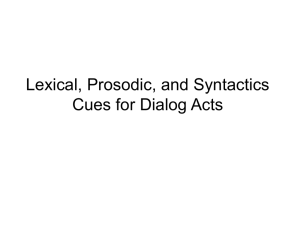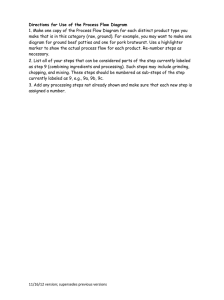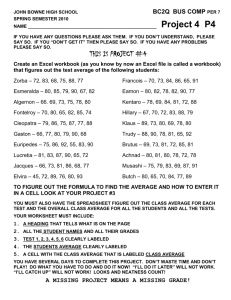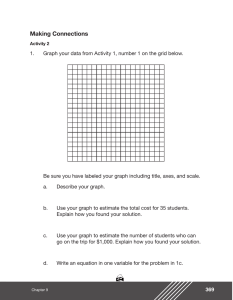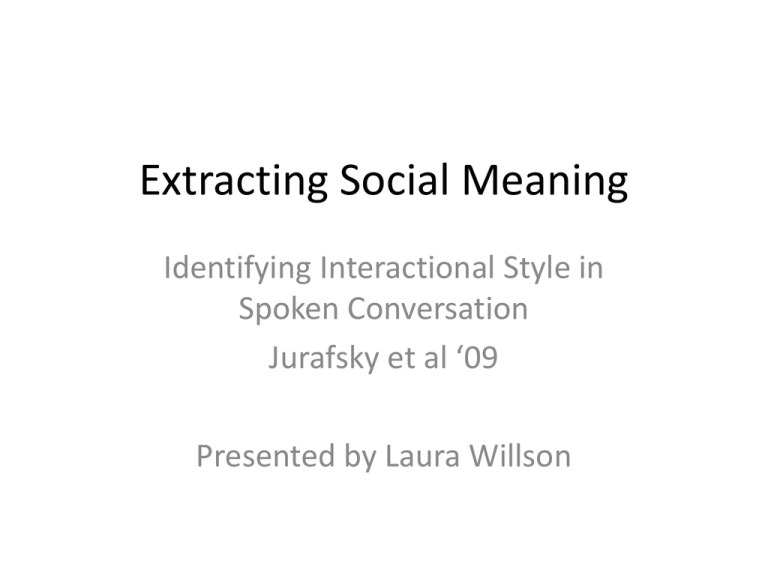
Extracting Social Meaning
Identifying Interactional Style in
Spoken Conversation
Jurafsky et al ‘09
Presented by Laura Willson
Goal
• look at prosodic, lexical, and dialog cues to
detect social intention
• crucial for developing socially aware
computing systems
• detection of interactional problems, matching
conversational style, and creating more
natural systems
SpeedDate Corpus
• Grad students had 4 min dates with a member
of the opposite sex
• asked to report how often their date was
awkward, friendly, and flirtatious, each on a
scale of 1 to 10
• hand transcribed and segmented into turns
• 991 dates total
Classification
• For each trait, the top 10% on the 1 to 10
Likert scale was used as positive examples and
the bottom 10% as negative examples
• A classifier for each gender for the three traits
• Trained 6 binary classifiers using regularized
logistic regression
Prosodic Features
• Computed the features of the person who was
labeled by the traits, and also the person who
labeled them, the alter interlocutor
• features were extracted over turns
Prosodic Features
•
•
•
•
•
•
•
f0 (min, max, mean, sd)
sd of those
pitch range
rms (min, max, mean, sd)
turn duration averaged over turns
total time spoken
rate of speech
Lexical Features
Taken from LIWC
• Anger
• Assent
• Ingest (Food)
• Insight
• Negative emotion
•
•
•
•
•
Sexual
Swear
I
We
You
Lexical Features
• Total words
• Past Tense Auxiliary, used to automatically detect
narrative: use of was, were, had
• Metadate, discussion about the date itself: use of
horn, date, bell, survey, speed…
• The feature values were the total count of the
words in the class for each side
Dialog Act Features
•
•
•
•
•
•
Backchannels
Appreciations
Questions
Repair questions
Laughs
Turns
Dialogue Act Features
• Collaborative Completions
found by training tri-gram
models and computing
probability of the first
word of a speaker’s turn,
given interlocutor’s last
words
• Dispreferred actionshesitations or restarts
Disfluency Features
•
•
•
•
uh/um
restarts
speaker overlaps
they were all hand transcribed
Data Pre-processing
• standardized the variables to have zero mean
and unit variance
• removed features correlated greater that .7 so
that the regression weights could be ranked in
order of importance in classification
Results
Analysis -Men
Analysis -Women
Analysis- Awkward
• for women was 51%, not better than baseline
• for men increased restarts and filled pauses,
• not collaborative conversationalists, don’t use
appreciations
• prosodically, they there hard to characterize,
but quieter overall
Results
Analysis- Alters
• When women labeled a man as friendly, they
were quieter, laughed more, said ‘well’ more,
used collaborative completions, and
backchanneled more
• For men who labeled women as friendly, they
used an expanded intensity range, laughed
more, used more sexual terms, used less
negative emotional terms, and overlapped
more
Conclusion
• Perception of several speaking style differs
across genders
• Some features held across gender, like
collaborative completes for friendliness
• Easy to extract dialog acts (repair questions,
backchannels, appreciations, restarts,
dispreferreds) were useful

